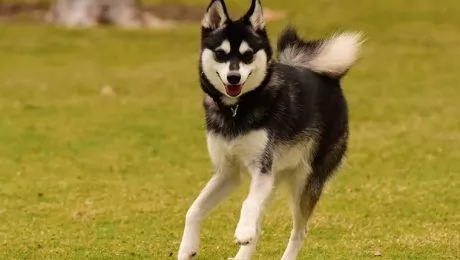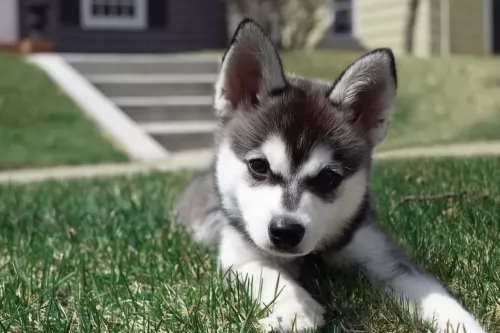 Petzlover
PetzloverAlaskan Klee Kai is originated from United States but Russian Setter is originated from Russia. Alaskan Klee Kai may grow 24 cm / 9 inches shorter than Russian Setter. Alaskan Klee Kai may weigh 17 kg / 37 pounds lesser than Russian Setter. Both Alaskan Klee Kai and Russian Setter has almost same life span. Both Alaskan Klee Kai and Russian Setter has same litter size. Alaskan Klee Kai requires Low Maintenance. But Russian Setter requires Moderate Maintenance
 Alaskan Klee Kai breed is created in Alaska by Linda S Spurlin with help of her family. When she saw a smaller type of Siberian Husky, she immediately wanted to create a smaller type of Husky that will be a great companion dog. She did not create this breed with dogs that suffer from dwarfism as if it’s the case with most other breeders. She breeds Alaskan Husky with smaller dog breeds that looked a like a husky. Breeds like Alaskan Eskimo Dog or Schipperke. They are still not recognized by some Kennel clubs, but their popularity is constantly on the rise.
Alaskan Klee Kai breed is created in Alaska by Linda S Spurlin with help of her family. When she saw a smaller type of Siberian Husky, she immediately wanted to create a smaller type of Husky that will be a great companion dog. She did not create this breed with dogs that suffer from dwarfism as if it’s the case with most other breeders. She breeds Alaskan Husky with smaller dog breeds that looked a like a husky. Breeds like Alaskan Eskimo Dog or Schipperke. They are still not recognized by some Kennel clubs, but their popularity is constantly on the rise.
People often think it is ridiculous that a Setter dog comes from Russia. It is believed that the Russians did have some kind of Griffon and the word Pointer is also often translated as Setter.
It is believed that the Russian Setter is one of the ancestors of the Wire-haired Pointing Griffon and that it possibly shared an ancestry with the German wire-haired and broken-haired pointers.
References to Russian Setters were fairly common in the 19th century, but there is such contradictory information that it is hard to get good information on the dogs. The Russian Setter is believed to have existed before the Russian Revolution resembling the English Setter. Dog experts tell us the dog no longer exists.
 Weight of the Alaskan Klee Klei variates from dog to dog, but average male size is between 33-44cm. While females size is 28-40cm. The weight of the average male, an adult dog is 13 to 15kg. As you may see Klee Klei can be very small dogs, and that depends on every dog.
Weight of the Alaskan Klee Klei variates from dog to dog, but average male size is between 33-44cm. While females size is 28-40cm. The weight of the average male, an adult dog is 13 to 15kg. As you may see Klee Klei can be very small dogs, and that depends on every dog.
A lifespan of Klee Klei is 12-16 years.
Litter Size of the breed again depends on every dog but normal size for this breed is between 4-8 puppies.
Other Name for Alaskan Klee Klei is just a Klee Klei.
In terms of appearance, it was John Henry Walsh who said that the Russian Setter was a dog hidden by its long, woolly matted coat.It seems to have been a medium sized dog with an elegant appearance. It seems the dog came in two varieties - the curly coated liver coated dogs and the fawn colored dogs which are straight coated.
Because there is very little information on these dogs, we assume they were between 57 – 68cm in height and between 27 and 32kg in weight. The coat was no doubt in colours such as grey, reddish-brown with some black and white and shortish and wiry. The ears were floppy,and the face no doubt had some longer hair around the muzzle.
Nobody seems to know exactly what the temperament of this dog was, but when you look at some of his ancestors you can assume that he was strong-willed, confident and a skilled hunter.
He would have required a lot of exercise too. He was lively and energetic. Because he had Pointer in him you can be sure that he would have been intelligent so that he could be trained and socialized.
He would have been keen to learn with an owner who was firm and consistent in his treatment of him. He is a dog most happiest when he can spend time with his human family, a most loyal and devoted family friend, capable of getting on well with children and pets in the home.
 Klee Klei is very intelligent breed with a lot of energy. They love spending time with the family, especially in the outdoor activities. Klee Klei is very friendly towards children and new people, but they will also be excellent watchdogs too. Due to their intelligence, they are very easy to train. You should practice a positive way of awarding for them. They love pleasing and they love food, so it is a match made in heaven for training the Klee Klei. They will enjoy playing with other animals because they love to run and spend time with them, but you must socialize them from the early age. It is very important to socialize them with other animals and you will not have anything to worry about. They have a high prey drive so you will have to keep them on the leash while walking because if they notice something they will run towards it immediately. So for your, and your pet's safety, it is the best to keep the leash on. They do not bark a lot, but they will express when they are not pleasured because they can be very sensitive
Klee Klei is very intelligent breed with a lot of energy. They love spending time with the family, especially in the outdoor activities. Klee Klei is very friendly towards children and new people, but they will also be excellent watchdogs too. Due to their intelligence, they are very easy to train. You should practice a positive way of awarding for them. They love pleasing and they love food, so it is a match made in heaven for training the Klee Klei. They will enjoy playing with other animals because they love to run and spend time with them, but you must socialize them from the early age. It is very important to socialize them with other animals and you will not have anything to worry about. They have a high prey drive so you will have to keep them on the leash while walking because if they notice something they will run towards it immediately. So for your, and your pet's safety, it is the best to keep the leash on. They do not bark a lot, but they will express when they are not pleasured because they can be very sensitive
It appears, according to records that the Russian Setter has come and gone. However he would have been a calm, gentle pet with running ad hunting keeping him happy. He would therefore have required a lot of exercise.
We can assume that according to the few records that there are, that this was an affable, pleasing dog breed which made a great family pet.
 As most of the small breed dogs that are mixed with various breeds, this is one of the healthiest breeds. They do not have a lot of health issues, and usually, they tend to live a lot. Of course, you must be careful where are you buying your dog, and it is very important to choose the right owners that are taking care of the dogs and puppies. Some of the issues that this breed might have are luxation patella, thyroid disease, heart conditions, liver shunts, factor VII deficiency, and cataracts.
As most of the small breed dogs that are mixed with various breeds, this is one of the healthiest breeds. They do not have a lot of health issues, and usually, they tend to live a lot. Of course, you must be careful where are you buying your dog, and it is very important to choose the right owners that are taking care of the dogs and puppies. Some of the issues that this breed might have are luxation patella, thyroid disease, heart conditions, liver shunts, factor VII deficiency, and cataracts.
The Russian Setter had an average lifespan of 10 – 14 which is a fairly good innings for a dog. Nonetheless you would have had to be aware of some common dog problem. These dogs were prone to major health issues such as both hip and elbow dysplasia, deafness, epilepsy and hypothyroidism.
The thyroid glands produce hormones that affect the function of many parts of the body. Dogs with this illness have a low production of thyroid hormones.
This disease is mainly caused by inflammation or shrinkage of the thyroid gland. The most common signs of low thyroid in dogs is thinning of the fur, the coat is dull, there is weight gain and excess shedding. The dog doesn’t tolerate cold well either. These dogs also often have ear infections.
 Since they are highly energetic dogs they will need a lot of fuel for playing and spending time outside. Feeding of your dog depends on daily activity, but overall you should consult with dog nutritionist for a better understanding of your dog needs.
Since they are highly energetic dogs they will need a lot of fuel for playing and spending time outside. Feeding of your dog depends on daily activity, but overall you should consult with dog nutritionist for a better understanding of your dog needs.
Puppies need more food divided into 3-5 meals per day. They would eat everything you have for them. 3-5 high-quality dry food would be enough with additional vitamins and minerals.
Normally, Klee Klei groom themselves, so you won’t have to do it too often. Again, you will have to take care of your dog with occasional baths and brushing. You will know when is the time to take care of your lovely Klee Klei, but they will do most of the work.
Whatever kind of coat the Russian Setter ad it would have required a brushing twice a week to keep it in top form.
The medium length floppy ears would have to be checked inside for ear infection.
His owners would have checked inside the mouth for any signs of rotten or bad teeth.
His nails would have required trimming.
Dogs need the best food there is to stay healthy. The Russian Terrier, if it were still around today, would have had the best commercially manufactured food there was.
You want to provide dogs with some good homemade food too. Dogs thrive on simplicity and consistency to avoid upsetting the stomach. Some home-cooked food such as boiled chicken, sweet potatoes, brown rice or pasta, carrots and spinach would be perfect for him. Chop the food up finely and add it into the dry kibble once or twice a week. Raw meat should also be added in when possible to promote good skin health.
Make sure your pet is never without a constant supply of fresh, cool water.